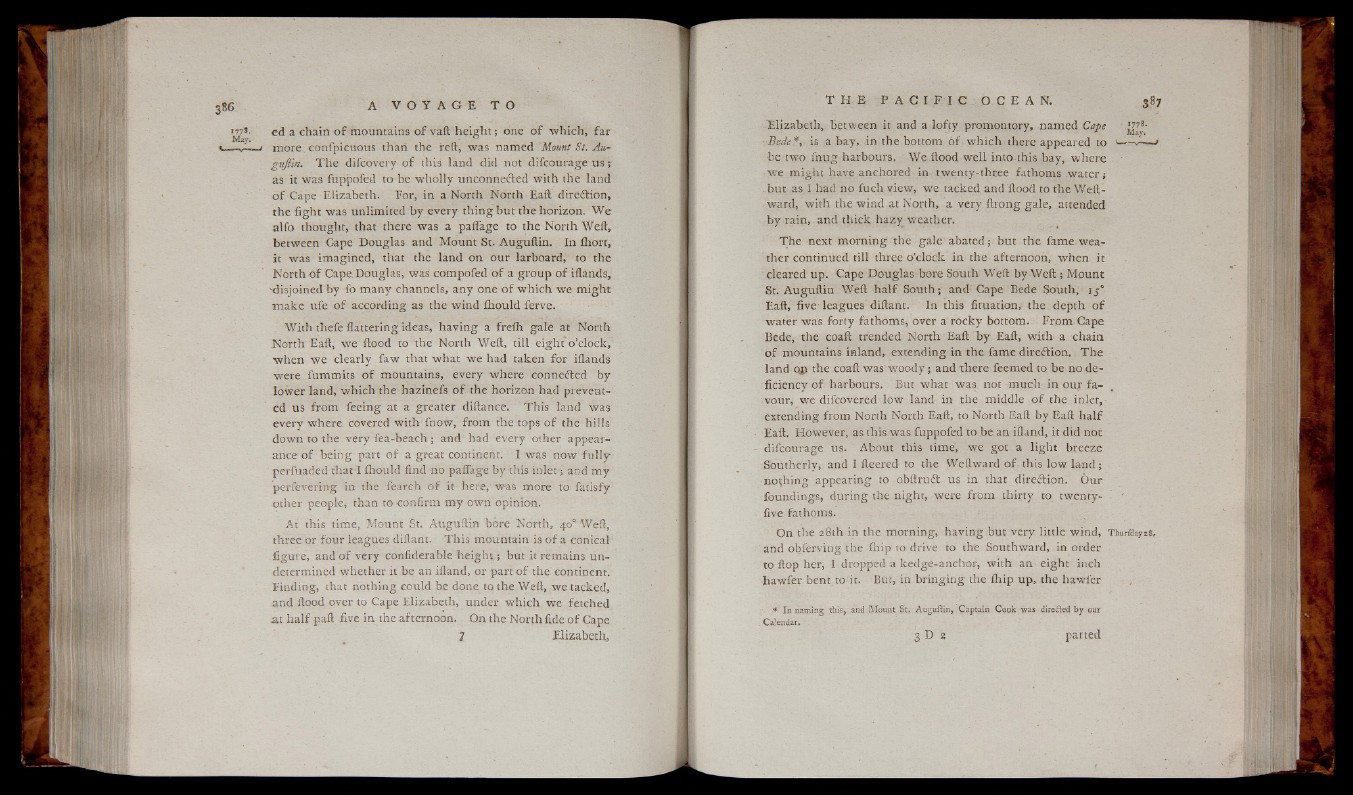
ed a chain o f mountains o f vaft h e ig h t ; one o f which, fa r
more confpicuous than the reft, was named Mount St. Au-
gufi'in. T h e difcovery o f this land did not difcourage us r
as it was fuppofed to be wholly unconnected with the land
o f Cape Elizabeth. For, in a North North Eaft direction,
the fight was unlimited by every thing but the horizon. W e
alfo thought, that there was a paflage to the North Weft,
between Gape Douglas and Mount Sr. Auguftin. In ihort,
it was imagined, that the land on our larboard, to the
North o f Cape, Douglas, was compofed o f a group o f iilands,
'-disjoined”by fo many channels, any one o f which we migh t
make ufe o f according as the wind ihould ferve.
With thefe flattering ideas, h a v in g a freih gale at North
North Eaft, w e flood to the North Weft, till eight o’clock,
when w e clearly faw that what we had taken for iflands
were fummits o f mountains, every where connected by
lower land, which the hazinefs o f the horizon had prevented
us from feeing at a greater diftance. This land w a s
every where covered with fnow, from the tops o f the h ills
down to the ve ry fe a -b ea ch ; and1 had every other appearance
o f being part o f a great continent. I was now fu lly
perfuaded that I ihould find no paflage by this in le t ; and my
perfevering in the fearch o f it here, was more to fatisfy
other people,- than to confirm my own opinion.
At this time, Mount St. Auguftin bore North, 40° Weft,
three or four leagues diftant. T h is mountain is o f a conical
figure, and o f ve ry confiderable h e ig h t ; but it remains undetermined
whether it be an ifland, or part o f the continent.
Finding, that nothing could be done to the Weft, we tacked,
and flood over to Cape Elizabeth, under w hich we fetched
a t h a lf paft five in the afternoon. On the North fide o f Cape
7 Elizabeth,
Elizabeth, between it and a lo fty promontory, named Cafe
Bede*, is a bay, in the bottom o f w h ich there appeared to 1——v— j
be two fn u g harbours. We flood well into this bay, where
we might have anchored in twenty-three fathoms w a te r ;
but as I had no fuch view, we tacked and flood to the Weft-
ward, with the wind at North, a very ftrong gale, attended
b y rain, and thick ha zy weather.
The next morning the ga le abated; but the fame weather
continued till three o’clock in the afternoon, when it
cleared up. Cape Douglas bore South Weft by Weft ; Mount
St. Auguftin Weft h a lf Sou th; and Cape Bede South, 15°
Eaft, five leagues diftant. In this fituation, the I depth o f
water was forty fathoms, over a ro ck y bottom. From Cape
Bede, the coaft trended North Eaft by Eaft, with a chain
o f mountains inland, extending in the fame direction. T h e
land qp the coaft was w o o d y ; and there feemed to be no deficiency
o f harbours. But what was not much in our favour,
we difcover.ed low land in the middle o f the inlet,
extending from North North Eaft, to North Eaft b y Eaft h a lf
Eaft. However, as this was fuppofed to be an ifland, it did not
difcourage us. About this time, w e got a light breeze
Southerlyj and I fleered to the Weftward o f this low lan d ;
nothing appearing to obftruit us in that direction. Our
foundings, during the night, were from thirty to twenty-
five fathoms.
On the 28th in the morning, ha vin g but very little wind, Thurfdayzs,
and obferving the ihip to drive to the Southward, in order
to flop her, I dropped a kedge-anchor, with an eight inch
hawfer bent to it. But, in b ringing the ihip up, the hawfer
* In naming this,, and Mount St. Auguftin, Captain Cook was directed by our
Calendar.